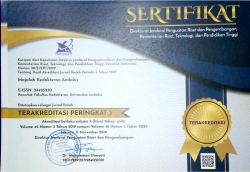HUBUNGAN KADAR BETA.SITE APP.CLEAVING ENZYME 1, BETA-AMYLOID DAN 4 HYDROXINONENAL PLASMA DENGAN GANGGUAN FUNGSI KOGNITIF PADA PENDERITA PASCASTROKE ISKEMIK
Abstract
Background: The levet of beta-amyloid (Ap) in the cerebrospinal fluid (CSS) can beused as
a marker to detect cognitive impairment, but fhe CSS retrieval technique is invasive. so if r's
necessa4z fo find biomarkers that are relatively easy, cheap and reliable. Therefore, biomarkers
that can be measured in blood is needed.
Aims: To determine fhe association of the blood levels of BACE-I, AB and 4HNE with ischemic
cognitive functisn after stroke event.
Methads: This study was an observational study with cross sectional design using cases and
controls. A number af 84 patients with ischemic stroke and 42 normal subjecfs as controls were
enrolled. Cognitive function u/as assessed 3 months aftdr stroke event using MoCA-lna test
and measurement of blood levels of BACE1-1, 4p40, AP42 and 4HNE was conducted within
72 hours of onset of stroke. Regression statistical analysis was used to determine the most
daminant factars related to the occurrence of impaired cognitive function after stroke event.
Resuffs; ln bivariate analysis, we found a significant assocrafion between cognitive impairment
after stroke with high blood levels of BACE1 (p = 0.004, OR = 1.714), low levels of AB40 (p =
A.0001, AR = 14.80) and low /eve/s of AB42 @ = A.U7, OR = 3.44). There was no significant
association between the blood levels of 4HNE with impaired cognitive function after stroke
event. ln multivariate analysis, we found low low plasma level of 4840, high level of BACE-1,
and low level of AB42 were variables strongly related with cognitive impairment after ischemic
stroke subsequently based on the strength of correlation.
Canclusians: Low levels of 4840, ttigh levels of BACE-I and low ievels of Ap42 are associated
with the incidence of impaired cagnitive functian after ischemic stroke.
M}(A, Volume 37, Nomor.Supl. 2, November 2014
MKA, Volume 37, Nomor.Supl. 2, November 2014 http:/imka.fk. u nand.ac. id/
ABSTRAK
Latar Belakang : Kecacatan pascastroke diperberat oleh terganggunya fungsi kognitif. Metode
diagnostik yang tersedia sekarang, tidak cukup sensitif bila digunakan sebagai upaya untuk
menemukan gangguan kognitif pascastroke secara dini. Kadar beta-amyloid (AP) di cairan
serebrospinal (CSS) dapat dijadikan sebagai penanda telah terjadinya gangguan kognitif,
namun teknik pengambilan CSS adalah invasive, sehingga perlu dicari biomarker yang relatif
mudah, murah dan dapat dipercaya. Untuk itu perlu dicarai biomarker pada plasma.
Tujuan : Untuk mengetahui hubungan kadar BACE-1, AB dan 4HNE plasma dengan fungsi
kognitif pascastroke iskemik.
Metode : Penelitian ini bersifat observasional dengan disain cross sectional, menggunakan
kasus dan kontrol. Mengikutkan 84 penderita pascastroke iskemik dan 42 subjek normal
sebagai kontrol. Fungsi kognitif diperiksa 3 bulan pascastroke dengan test MoCA-lna dan
pemeriksaan kadar BACEI-1, AF40, AP42 dan 4HNE plasma dalam 72 jam onset stroke.
. Analisa regresi statitistik digunakan untuk menetapkan faktor mana yang paling dominan
hubungannya dengan terjadinya gangguan fungsi kognitif pascastroke iskemik.
Hasil : Pada analisis bivariat, ditemukan hubungan yang bermakna antara gangguan kognitif
pascastroke dengan tingginya kadar BACE1 (p=0,004, OR= 4,714), rendahnya kadar AP40
(p=0,0001, OR=14,80) dan rendahnya kadar AP42 (p=0,0t7, OR=3,44). Tidak ditemukan
hubungan yang bermakna antara kadar 4HNE dengan gangguan fungsi kognitif pascastroke.
Pada analisis multivariat, didapatkan rendahnya kadar AB40 dan tingginya kadar BACE-
1 plasma sebagai variabel yang kuat hubungannya dengan kejadian gangguan kognitif
pascastroke iskemik.
Kesimpulan : Rendahnya kadar AB40 dan tingginya kadar BACE-1 plasma berhubungan
dengan kejadian gangguan fungsi kognitif pascastroke iskemik.
62





















